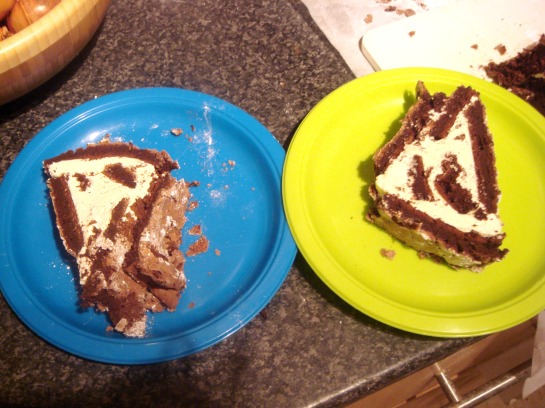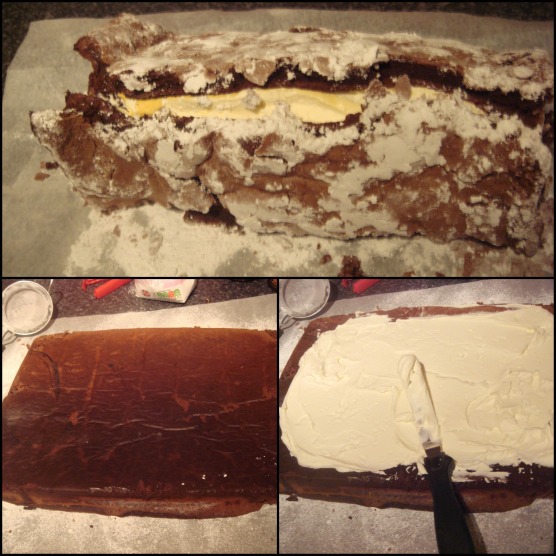This post is part of my personal challenge to bake my way through all the challenges of the Great British Bake Off. The challenge below is the technical challenge for week six (dessert week) of series two: Mary Berry’s chocolate roulade

Well, another round. I admit to having lost a bit of my baking and blogging mojo for a while. Not because I don’t still love baking – every time I do it I am reminded of how much I really do love it; and not because I don’t love the writing, because again when I get down to it it’s exciting and stimulating and time just flies by. And not even because of being in the fourth month of my diet, even though sweets and 1200-calories-a-day really don’t go at all (I have to spend a lot of time at the gym to earn myself some cake, but the results have absolutely been worth it!). No, it’s been something much more prosaic: simply not having much time between work and social commitments. Once upon a time, I did a part-time MA (well, I only graduated in April!) and I can’t imagine how I did that, in retrospect. No wonder I was always ‘very tense’, as my boyfriend delicately put it (he meant prone to lashing out in angry, tearful snaps in lieu of words).
Whenever I look at other blogs I see beautifully styled and well-lit photographs that glow from within. I tend to take my photographs in artificial light (because most of my cooking and baking is done when I get home from work) seconds before I start digging in. So I hope I can describe how really lovely, and simple, this roulade is, even if my photos may not do it full justice.

First of all, this Mary Berry is utterly unfancy, and, compared to many rich, exotically-flavoured cakes which are absolutely packed with nuts and fruit and alcohol and what have you, actually quite plain. Its appeal is based on the almost universally loved contrast between bitter chocolate and soft, fluffy white cream, which cuts the bitter edge despite not being sweetened. I found the sponge had a tendency towards dryness – you will need to watch it like a hawk to ensure it doesn’t overcook because, with a sponge this thin, it can easily happen. But even if you do it’s quite frankly not so much of an issue because the cream will provide the requisite moisture. There is something quite old-fashioned about it, even though the generous quantity of eggs, sugar, chocolate and cream mean it would have been quite a luxury in days gone by.
Chocolate roulade
From the BBC Food website
- 175g dark chocolate, finely chopped
- 6 free-range eggs, separated
- 175g caster sugar
- 2 TBS cocoa powder
- 300ml double cream
- icing sugar, to dust
- Preheat the oven to 180C. Lightly grease a 33cm x 23cm Swiss roll tin then line the base and sides of the tin with a large sheet of greaseproof paper, pushing it into the corners. Make a small diagonal snip in each corner of the paper; this helps to fit the paper snugly into the corners of the tin.
- Melt the chocolate in a bowl set over a pan of barely simmering water. (Do not let the base of the bowl touch the water.)
- Place the egg whites in a large bowl and whisk until stiff but not dry. If you turn the bowl upside down, the whites should be stiff enough not to fall out.
- Put the egg yolks in a separate bowl with the sugar and whisk using the same whisk (no need to wash it) on high speed for 2-3 minutes or until thick and creamy and the mixture leaves a thick ribbon-like trail when the beaters are lifted. Pour in the cooled chocolate and gently fold together until well combined.
- Gently stir two large spoonfuls of the egg whites into the chocolate mixture to loosen the mix, then fold in the remaining egg whites using a large metal spoon (you don’t want to squash out the air you have just beaten in). Sift the cocoa over the top and lightly fold it in. Pour the mixture into the prepared tin and gently move the tin around until the mixture is level. Ensure that this is done because, lacking fat, the sponge mixture will not self-level, unlike most other cakes.
- Bake in the preheated oven for about 20-25 minutes until risen and the top feels firm and slightly crisp. Remove from the oven, leave in the tin (expect the roulade to fall and crack a little) and set aside until cold. Unlike a Swiss roll, you don’t roll up a roulade while it cools.
- Whip the cream until it just holds its shape. Lay a large piece of greaseproof paper on the work surface and dust it lightly with icing sugar. Turn the roulade out on to the paper so its lining paper is on top, then carefully peel off the paper. Spread the roulade with the whipped cream, leaving a border of about 2cm all the way around the edges. With one of the shortest edges facing you, make a cut along it with a sharp knife, going about half way through the sponge (be very careful as it’s than you’d think to cut all the way through!). This will help to start the rolling up. Now roll this cut edge over tightly to start with and use the paper to help continue the tight rolling, by pulling it away from you as you roll. Don’t worry if the roulade cracks – that is quite normal and all part of its charm. (This is fortunate since mine basically cracked apart and barely held in the bulging cream).
- Finish with the join underneath then lift the roulade onto a serving plate or board using a large wide spatula or two fish slices. Dust with icing sugar.
